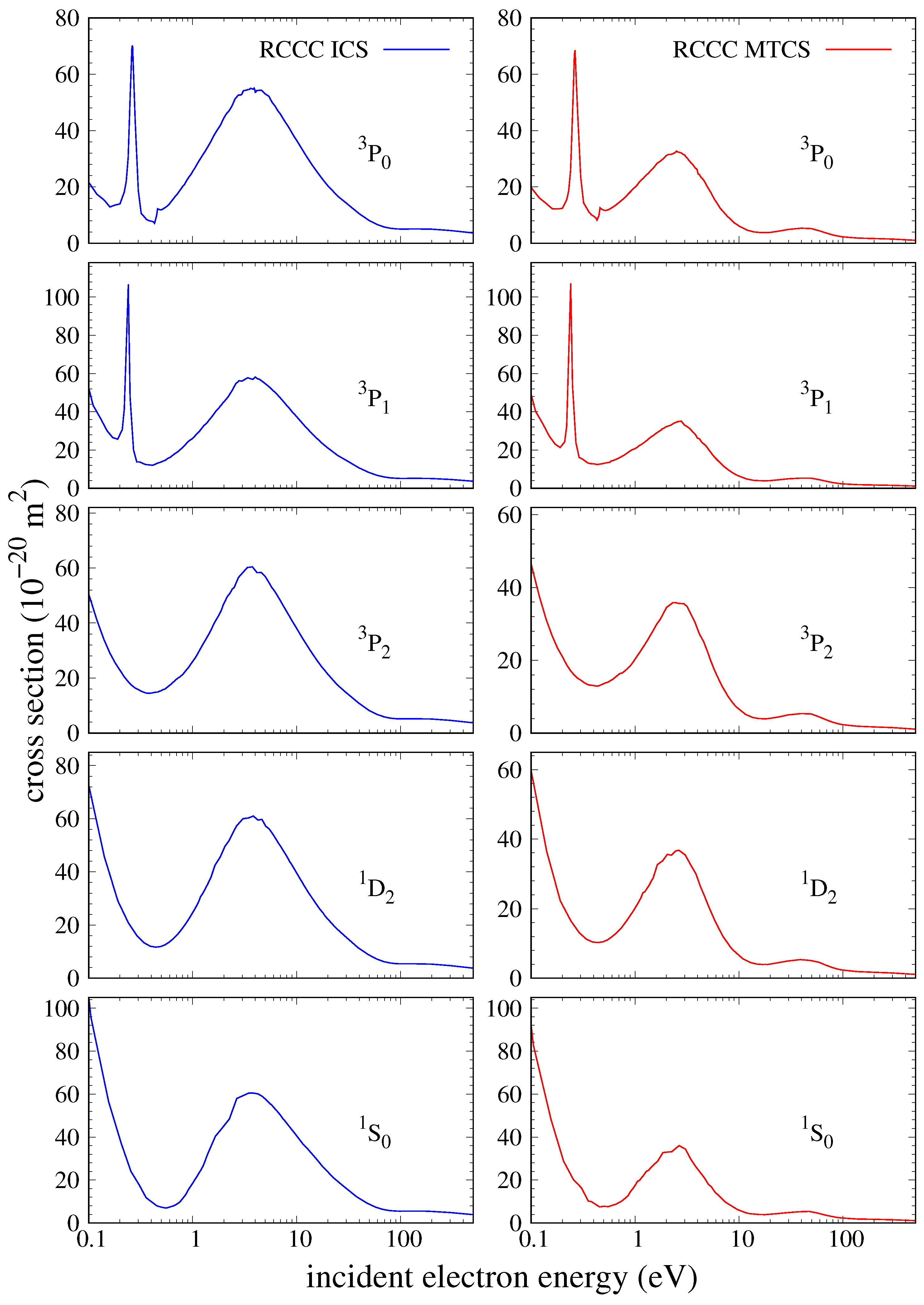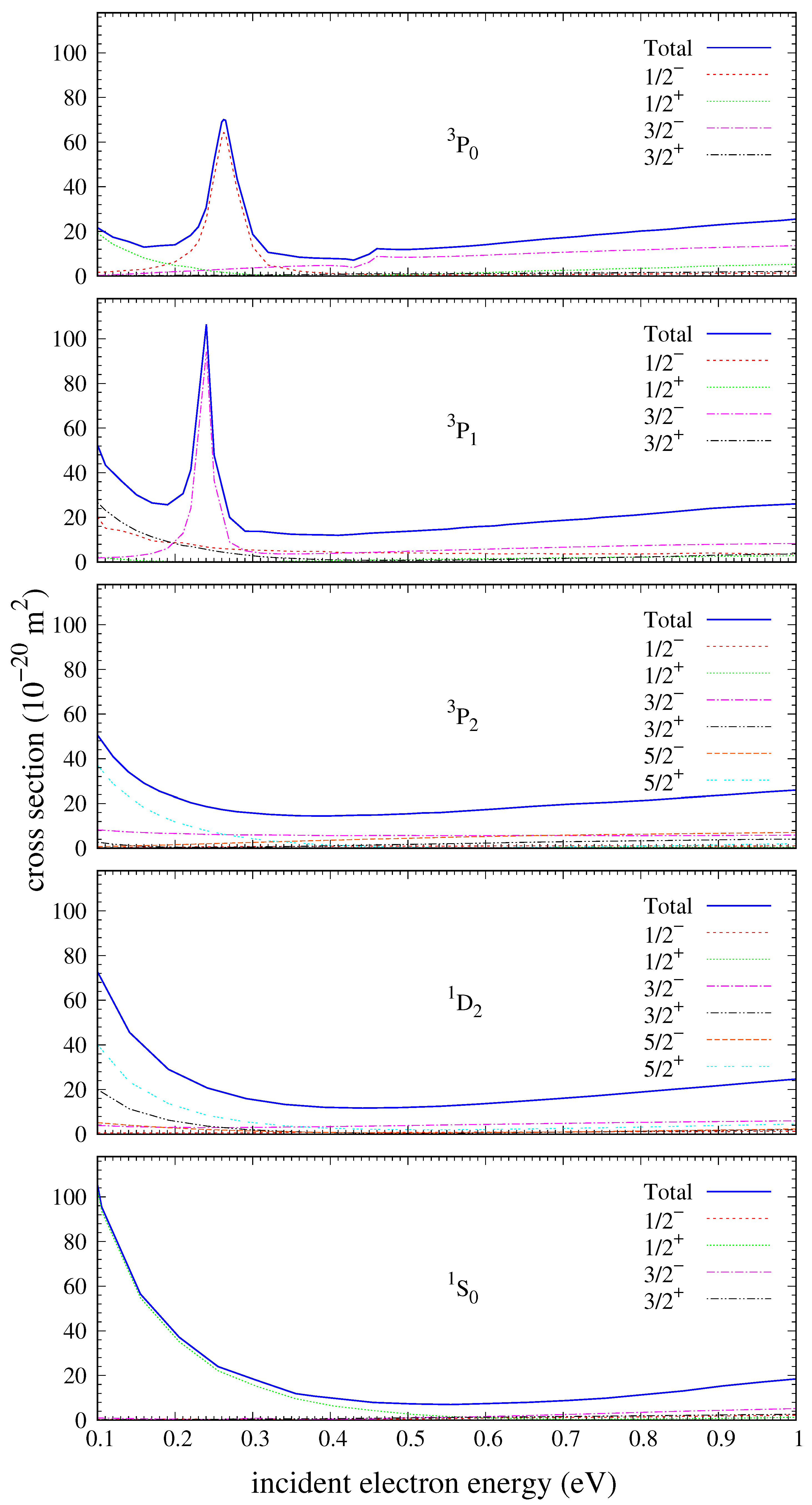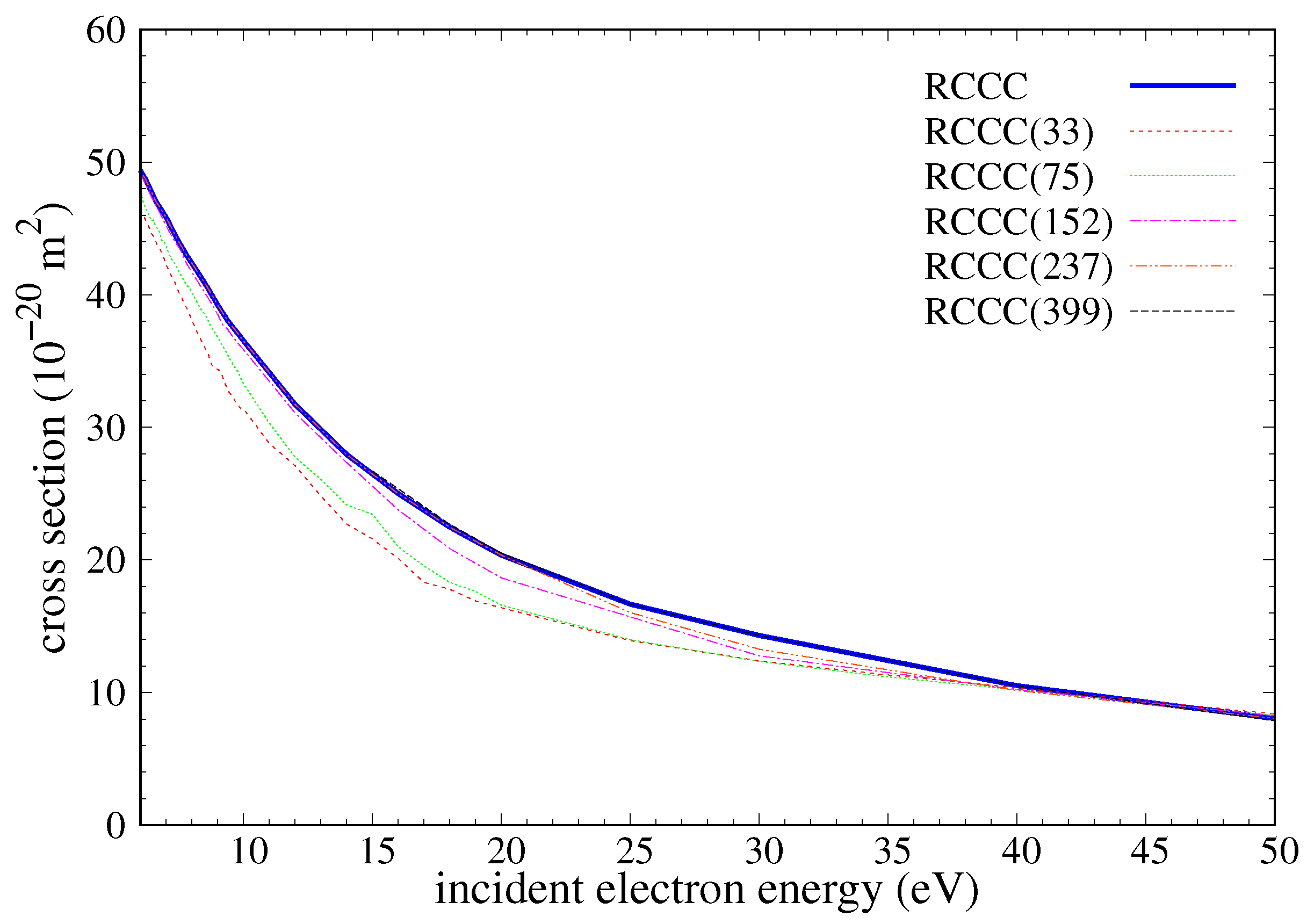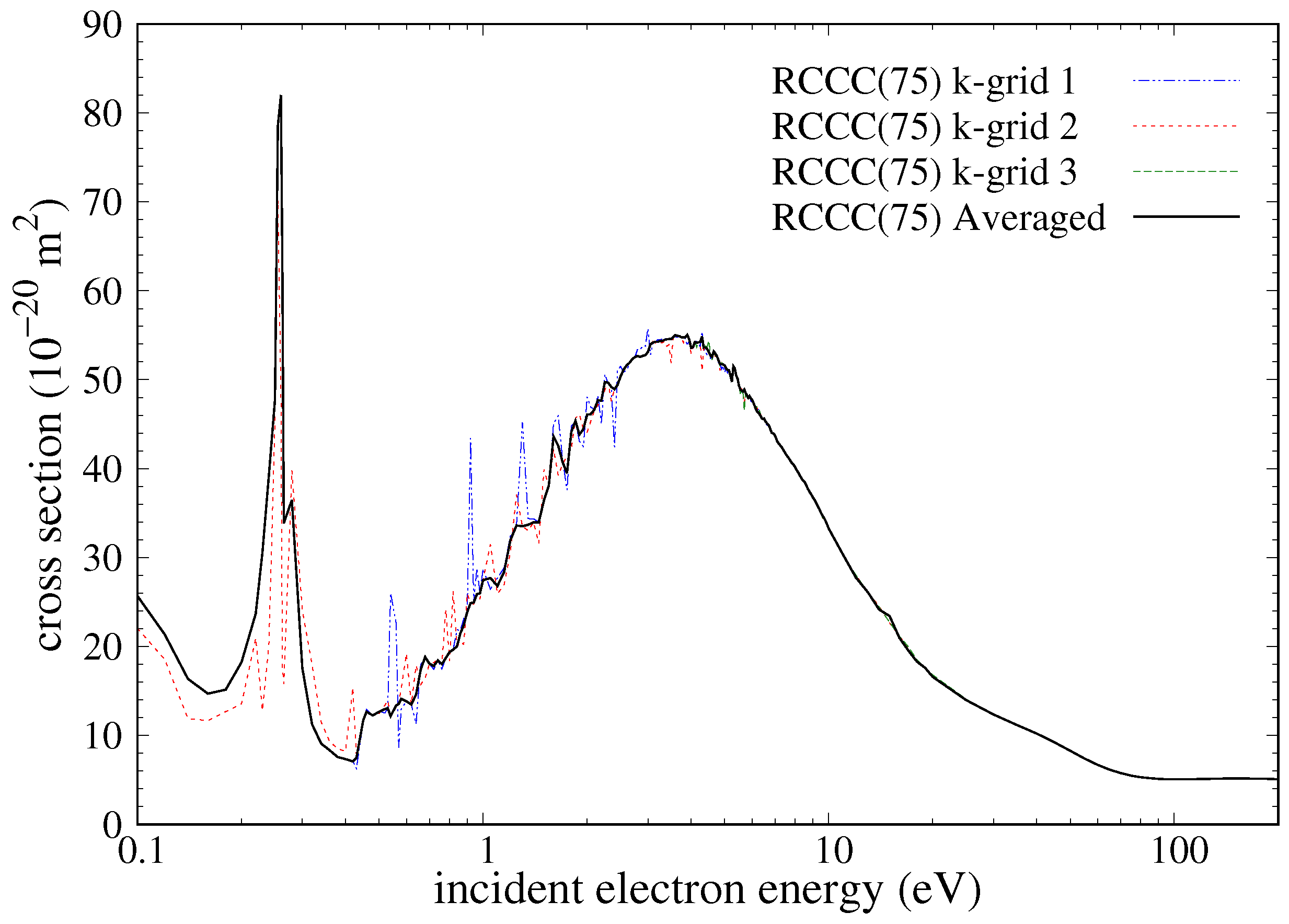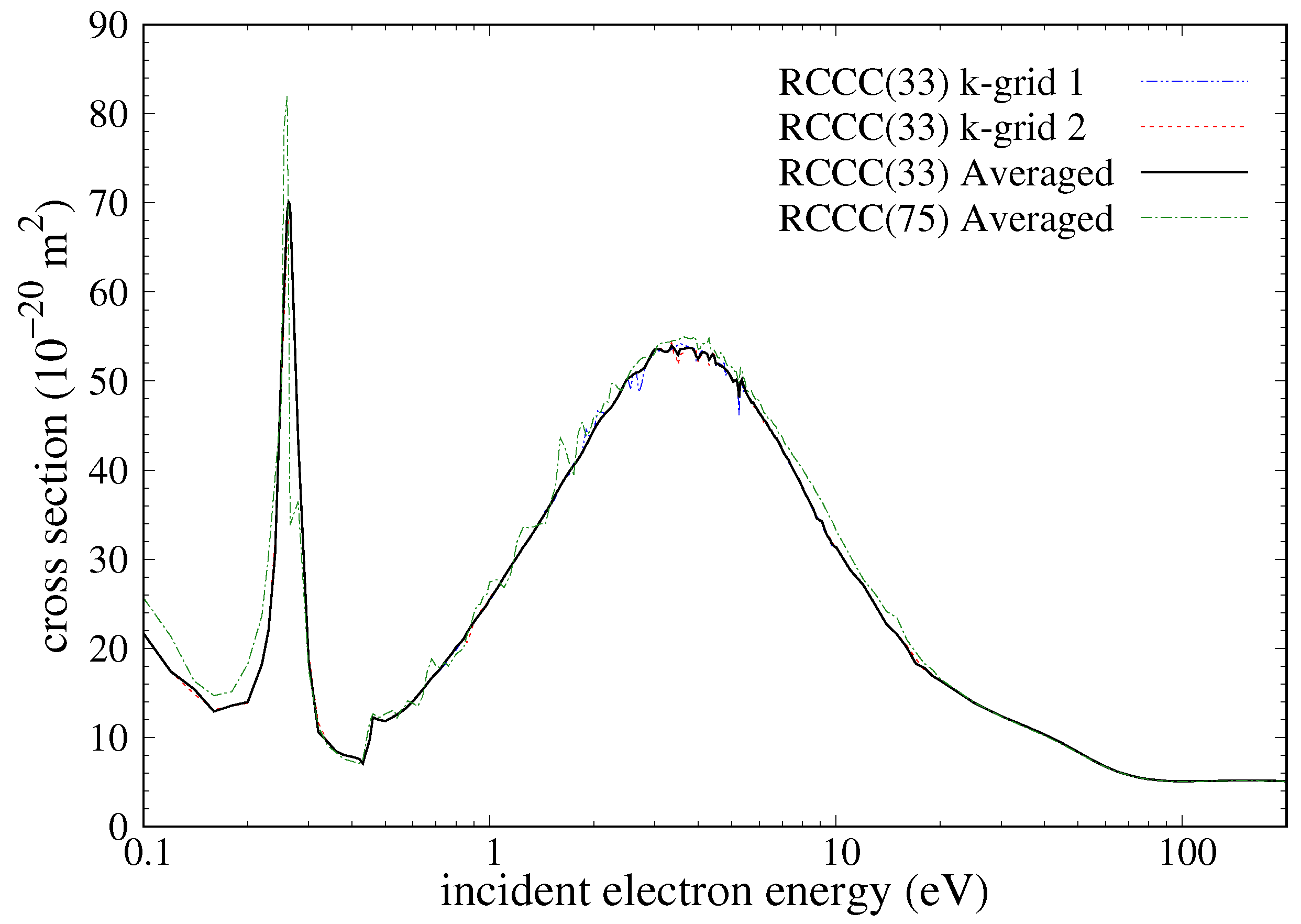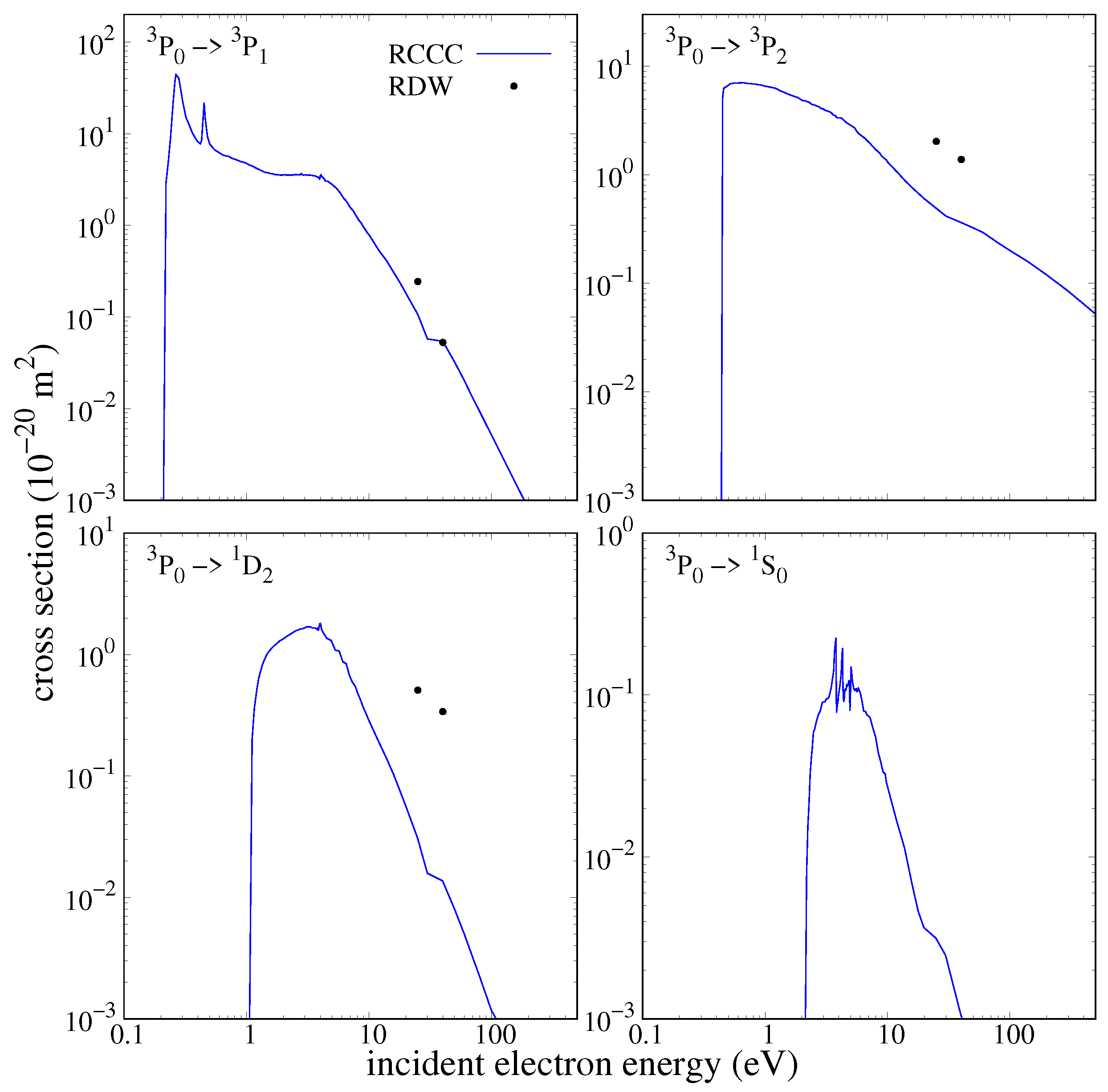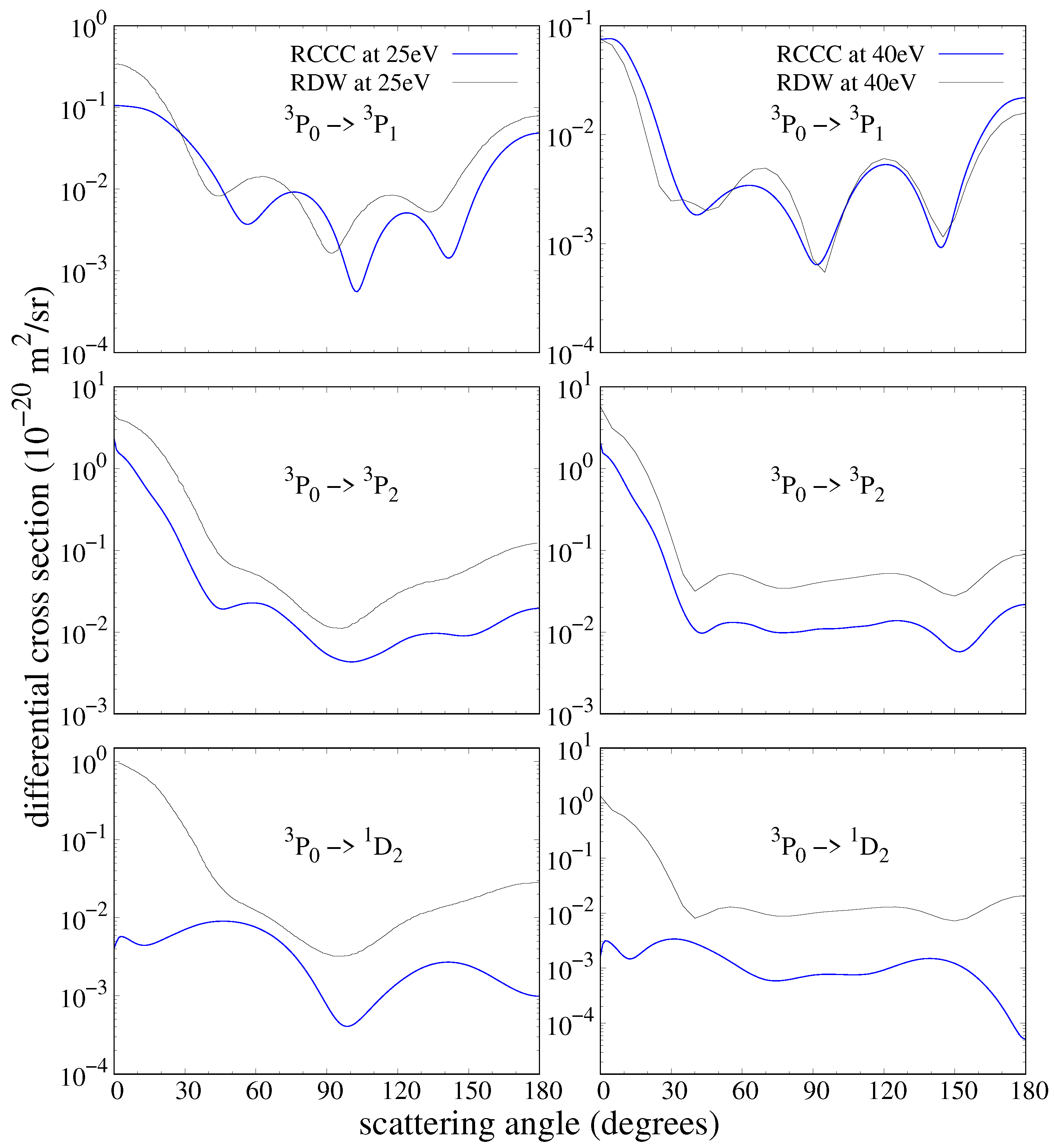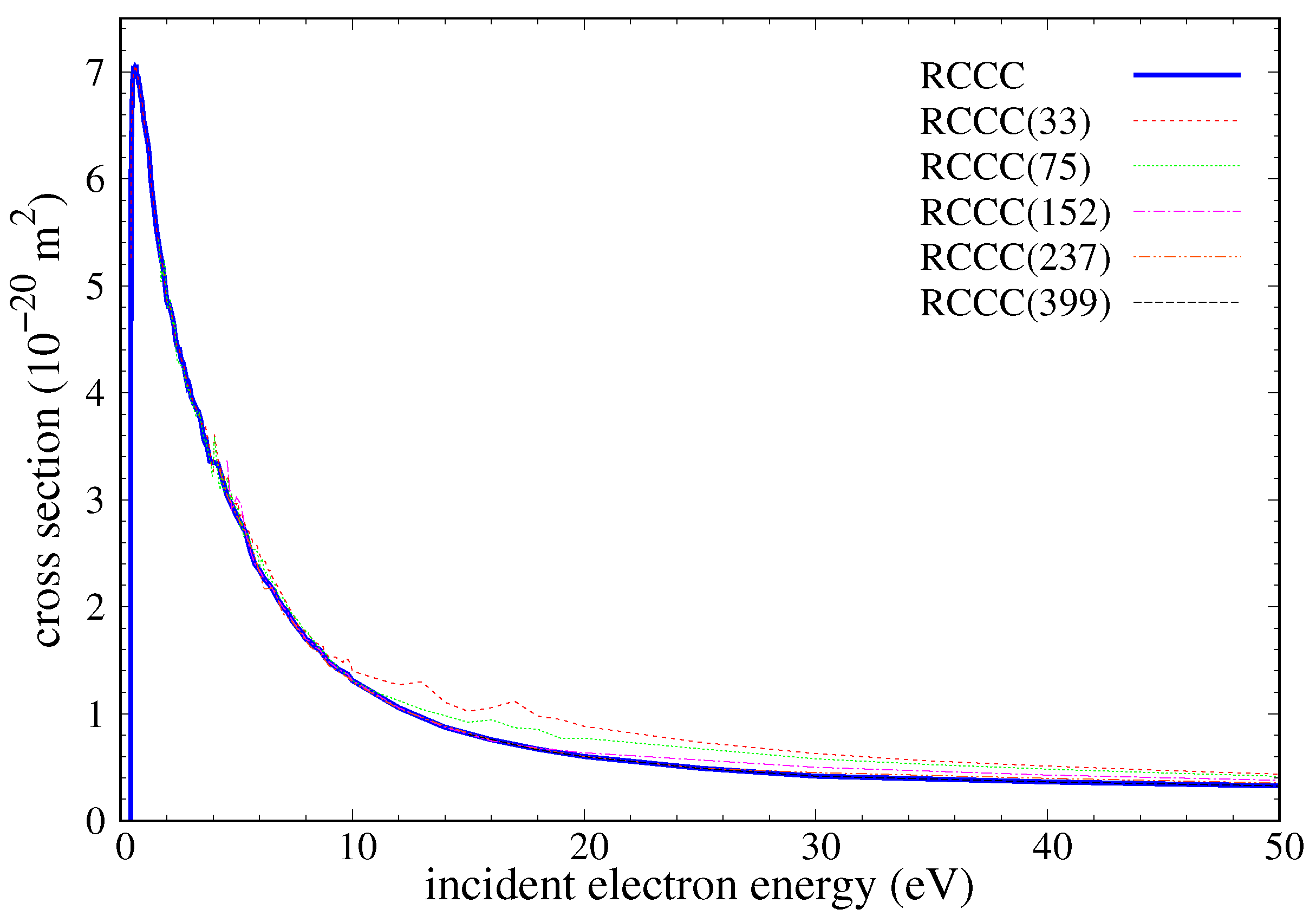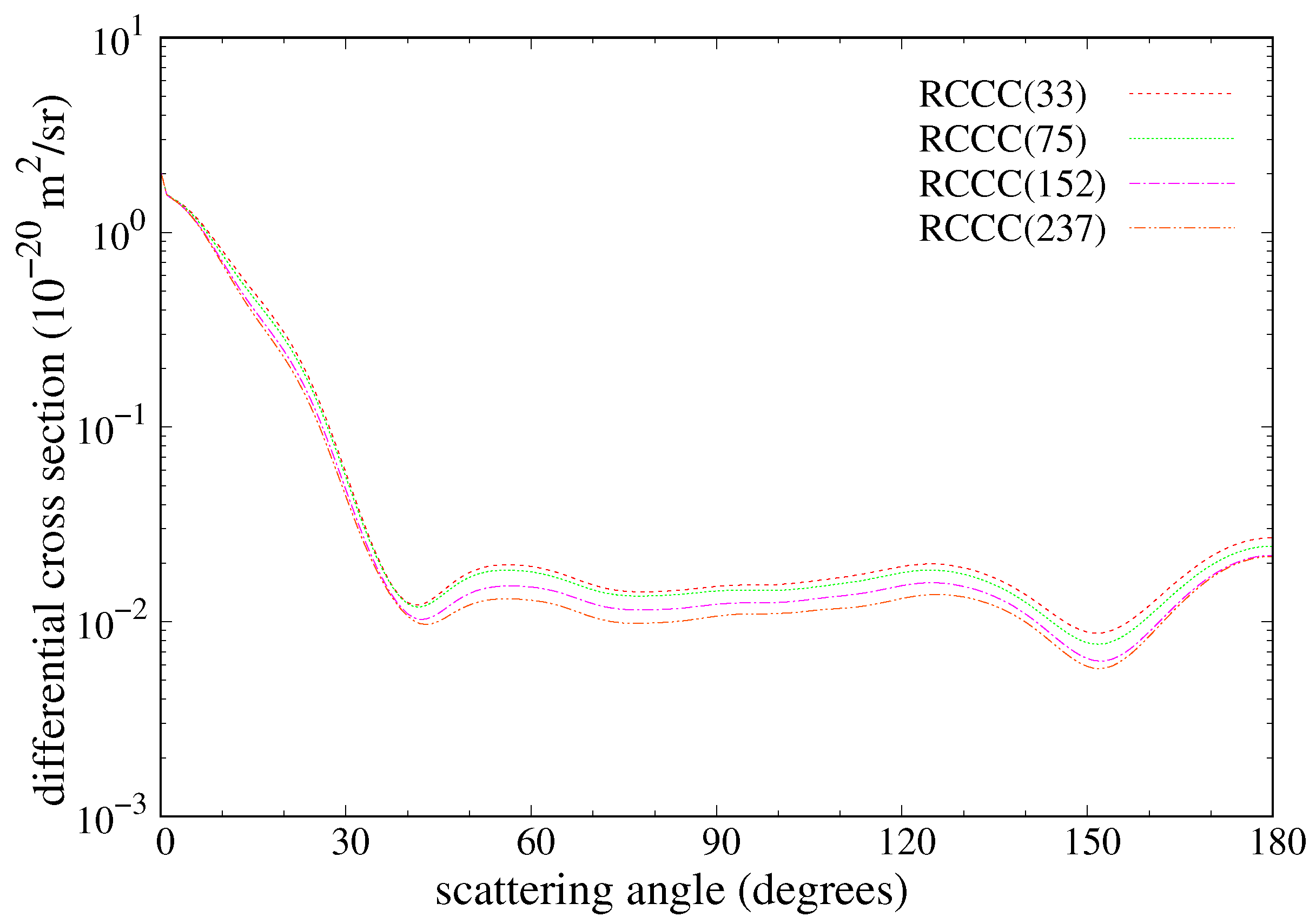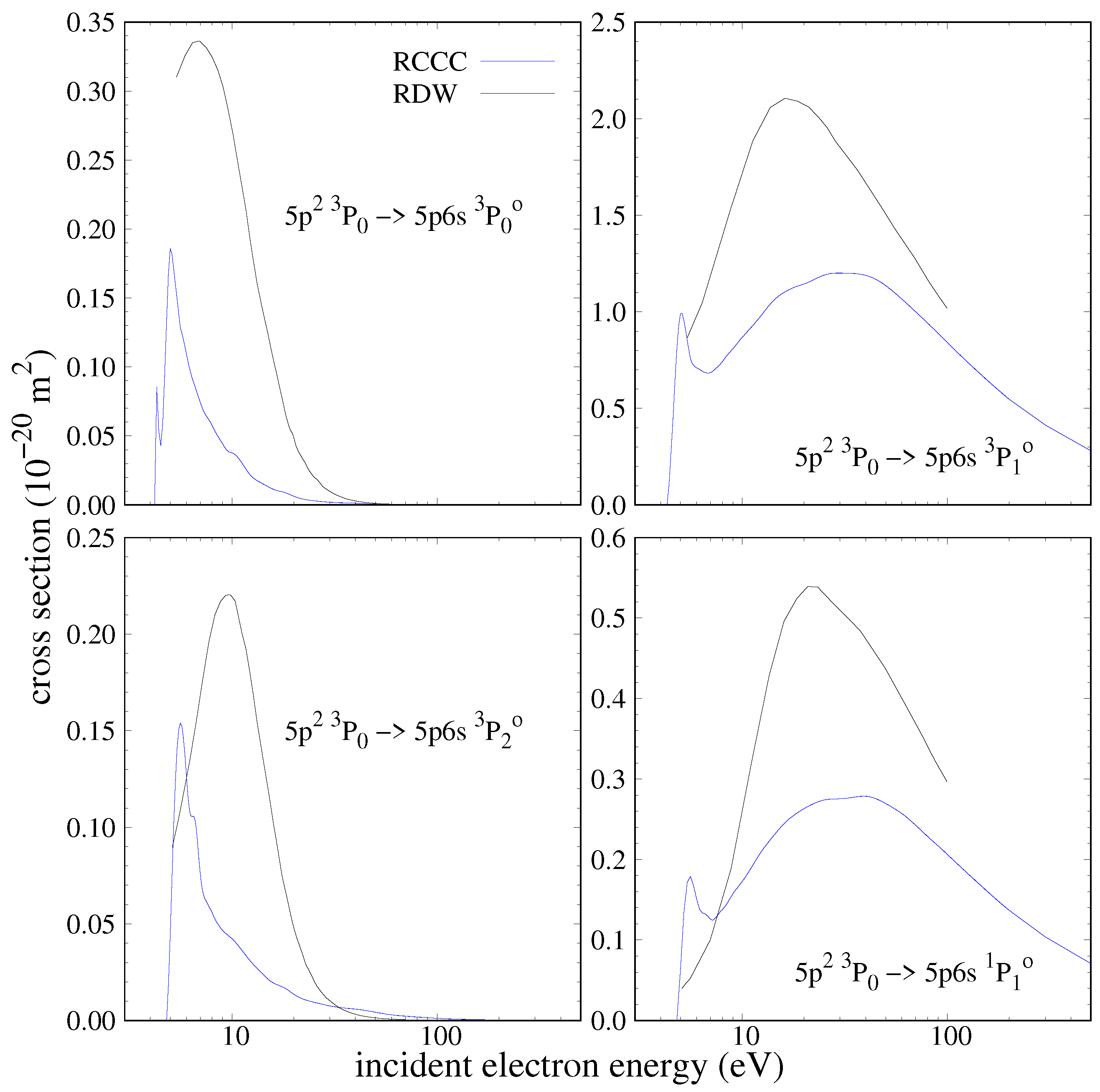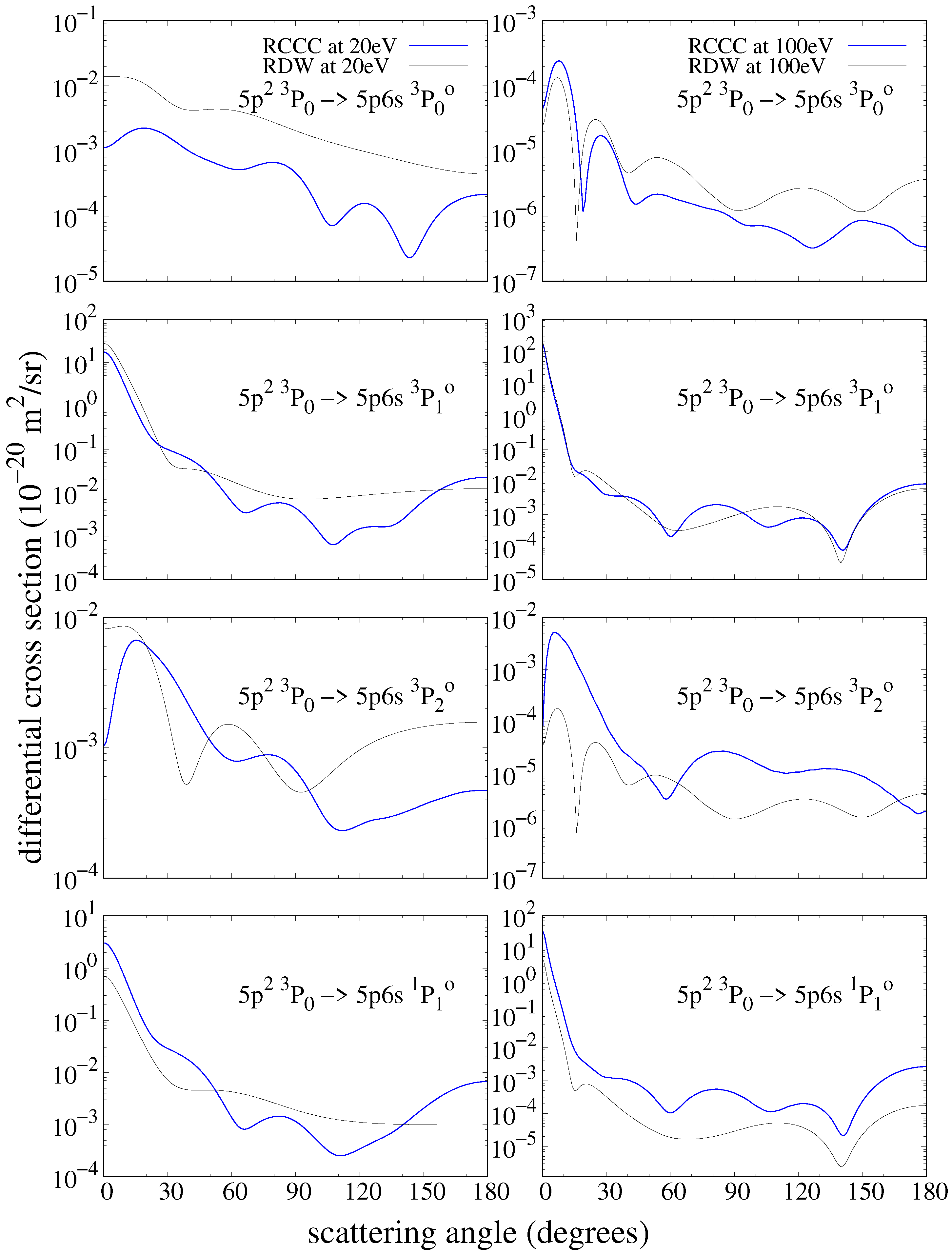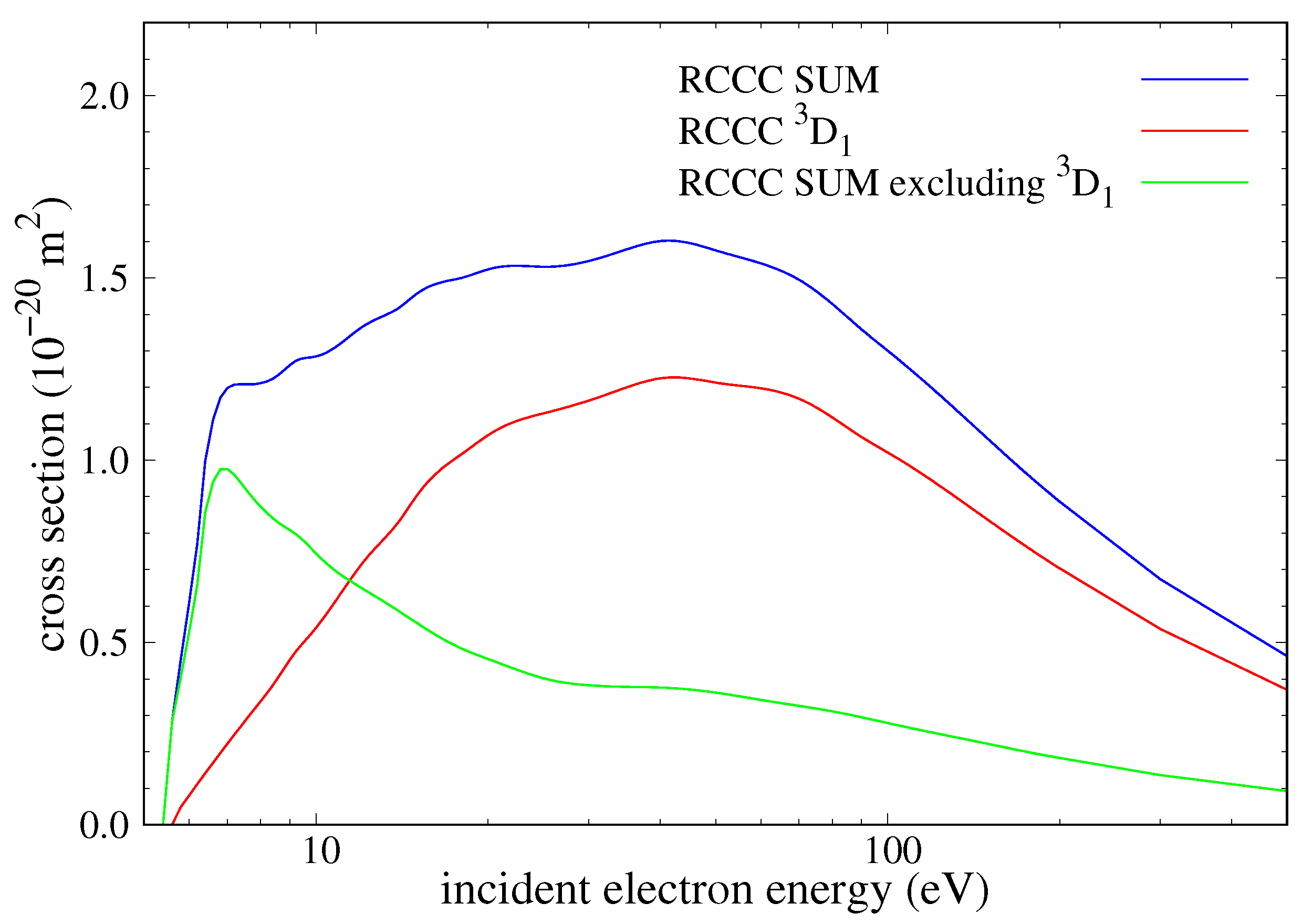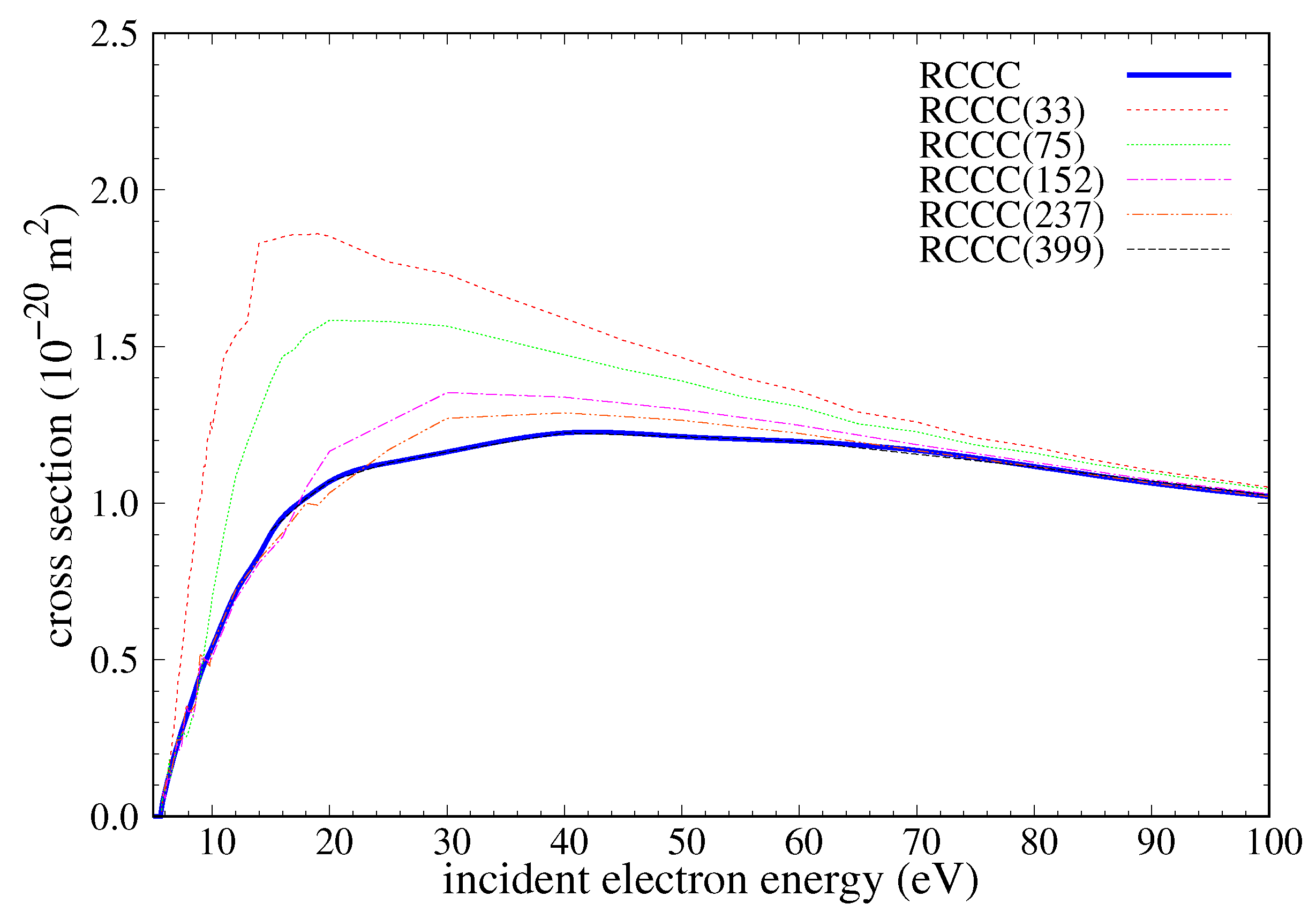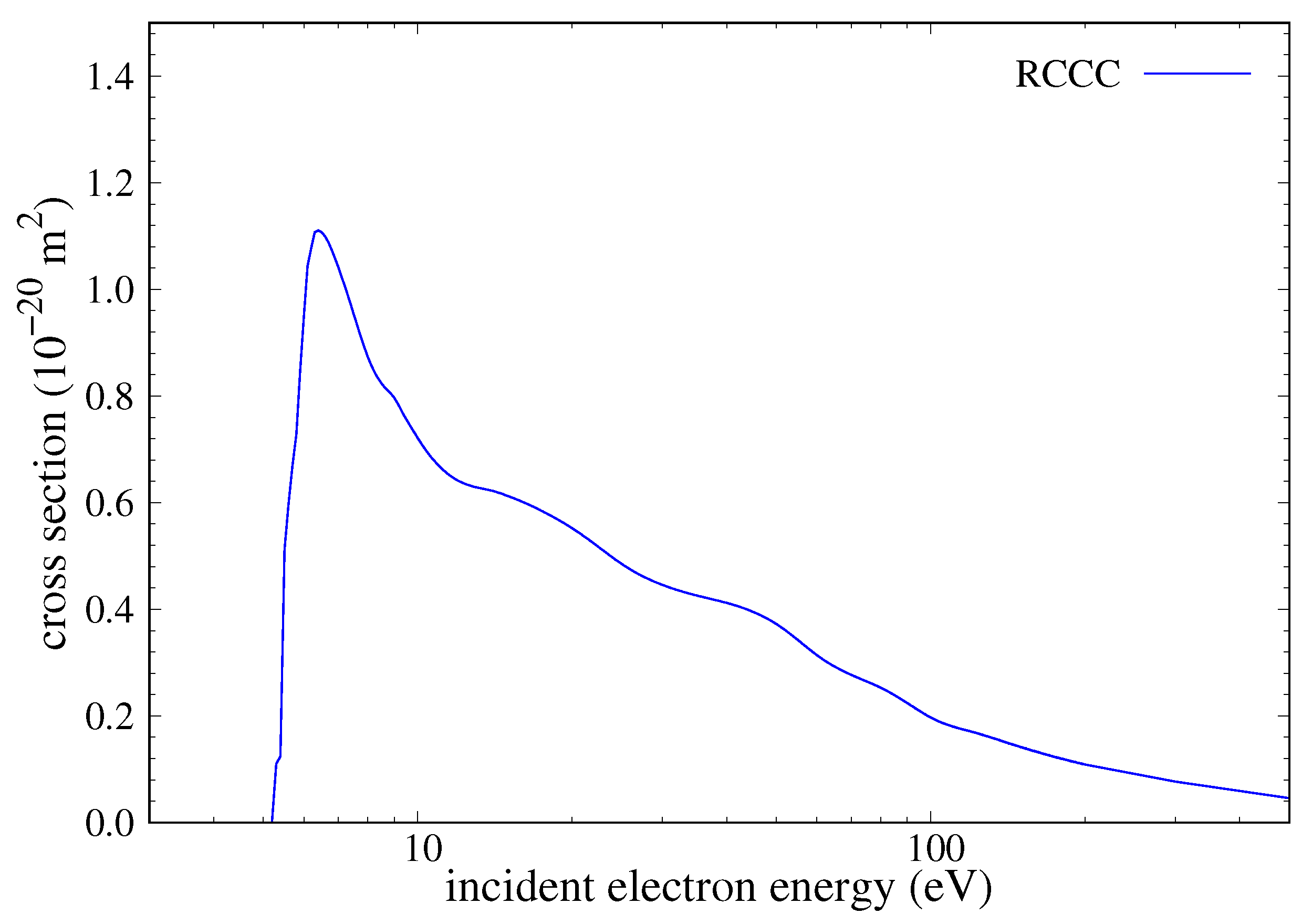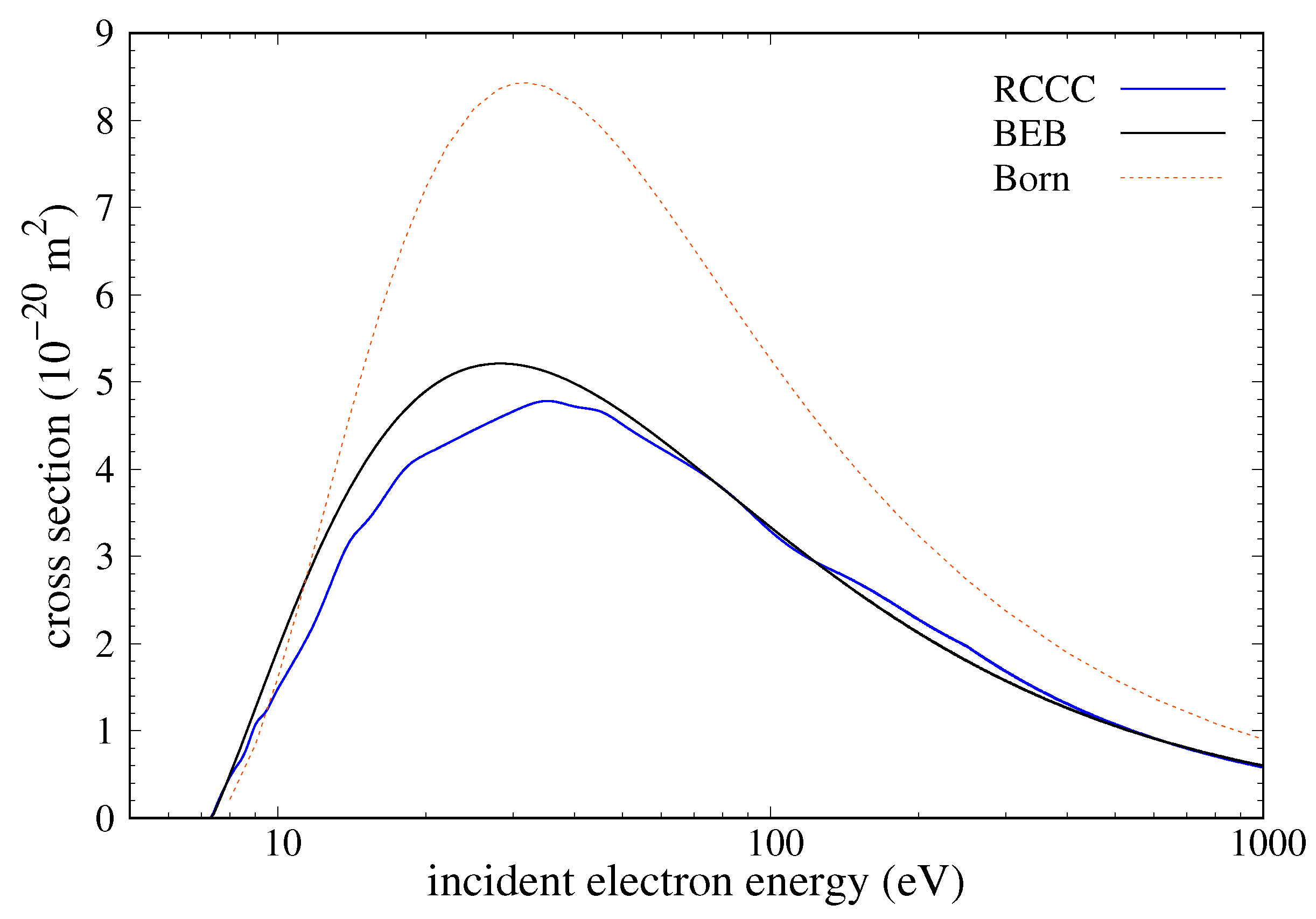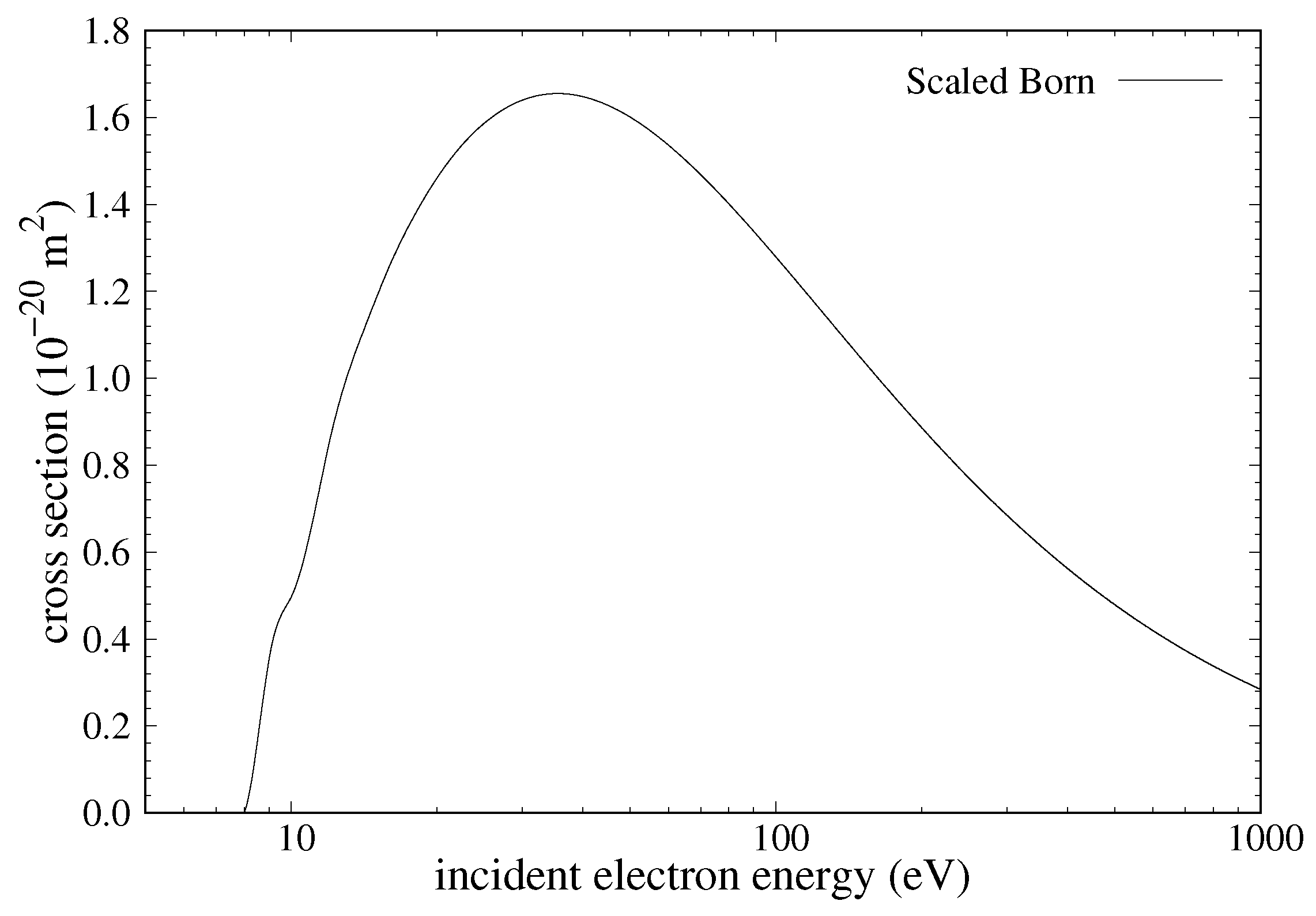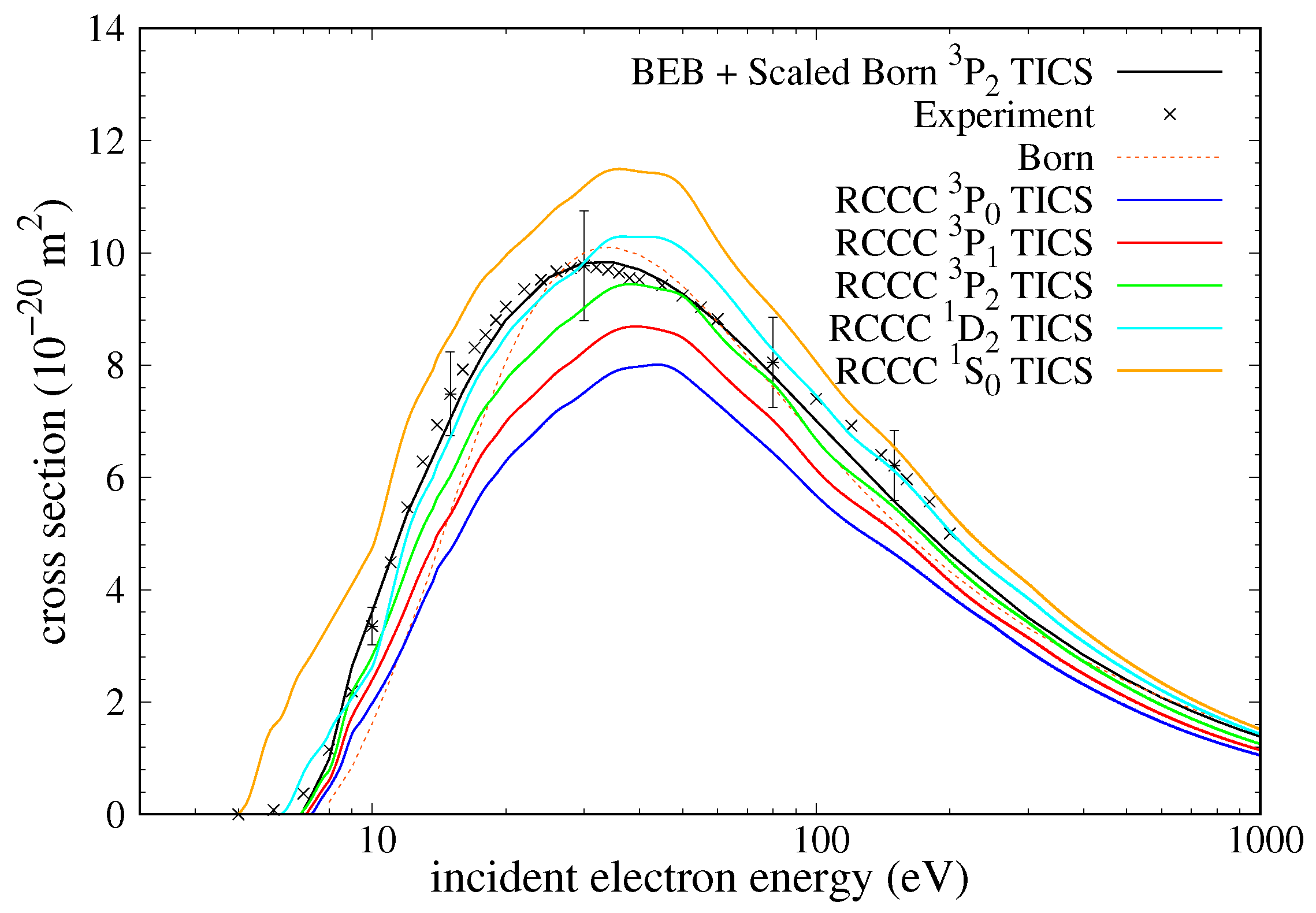We first present our results for the elastic scattering, including a discussion about the resonance behaviour. Secondly, we provide a comparison with the previous literature for excitation ICS and DCS to the manifold as well as the manifold from the ground state. Following this, we provide our estimates for the integrated cross sections to the and manifolds from the ground state. As most of the cross sections are small for transitions to these manifolds, we provide summed results only. We provide a discussion on the convergence of our RCCC models when appropriate. Finally, we present the total cross sections (TCS) and total ionisation cross sections (TICS) from the ground state and low-lying excited states, alongside a comparison with the experiment and previous theoretical results.
3.1. Elastic Scattering
In
Figure 1, we present our elastic scattering integrated and momentum-transfer cross sections for the ground and first four excited states of neutral tin. There is no previous experimental or theoretical data to compare with. The elastic ICS for scattering on the ground
state displays strong resonance behaviour, with a sharp peak arising at low energy (≈0.2 eV). The partial-wave decomposition for the elastic-scattering cross section is presented in
Figure 2 which shows the resonance is in the
and
partial wave. Given that the initial target state in this case has
and
, the projectile electron must have
and
. The projectile, therefore, is in a
p-wave. The existence of this resonance indicates a short-lived bound state formed between the projectile electron and the tin atom with the formation of Sn
−. This
p-wave resonance is visible again for elastic scattering on the first excited state (with term
), for which it appears in the
and
partial wave. The locations and magnitudes of these resonances changed marginally with the increasing static dipole polarisability within our models, and as models with larger numbers of states were unstable in this low-energy regime, the RCCC(33) model was utilised.
The resonance behaviour at about 0.2 eV is only present for elastic scattering from the ground and first excited states with the second, third and fourth excited states having smooth behaviour in that region. The cross section for the ground state has a small structure at about 0.4 eV. The partial-wave decomposition of this cross section, given in
Figure 2, shows that this behaviour comes from the
and
partial wave. The projectile is in a
p-wave, with
and
. All the elastic-scattering cross sections for the
manifold have a wide resonance which peaks at about 4 eV. The cross sections become relatively small from about 80 eV onwards. The momentum-transfer cross sections follow the same trends, except that they have smaller peaks and fall off much faster, becoming relatively small by 10 eV. At projectile energies of about 40–50 eV, the momentum-transfer cross sections also have a relatively small second peak.
Figure 3 demonstrates the convergence of the RCCC elastic-scattering cross section with the number of states included in the close-coupling expansion. There is good agreement between the two largest models (RCCC(237) and RCCC(399)) over the energy range, and all the models converge at high energy. The combined cross section refers to the final result produced by taking the appropriate RCCC models in different parts of the energy range. The low energy results shown in
Figure 1 and
Figure 2 are obtained from the smaller RCCC(33) and RCCC(75) models. The intermediate-to-high-energy regions are better represented by the RCCC(237) and RCCC(399) models. The larger models were only run at energies above 4 eV due to their significant computational cost. All the models suffer from the numerical instabilities related to the non-uniqueness of the solutions of the
T-matrix equations [
20], though the smaller models are effected less. In order to minimise the effects of numerical instability on our cross sections, we ran our calculations several times with differing numerical parameters and averaged the results to produce sufficiently smooth estimates.
The averaging procedure applied takes in two or more cross sections for the same scattering process which have been calculated using varying numerical parameters and produces a smooth result. The procedure calculates the gradient between adjacent points in the cross section and chooses the next point from either of the input calculations based on which minimises the change in the gradient.
Figure 4 illustrates the impact of the used averaging technique on the elastic-scattering cross section for the ground state calculated using the RCCC(75) model. A total of three slightly different momentum-space integration grids (
k-grids) were used, with one of them only being used to calculate for projectile energies greater than 4 eV. For the cross section below 4 eV, the RCCC(33) model was used as it is stable and sufficiently converged to the averaged RCCC(75) results as shown in
Figure 5. As the RCCC(33) model was sufficiently smooth over most of the projectile energy domain, it was only calculated using two different
k-grids which were then averaged using the described technique. Above 4 eV, the RCCC(75) averaged results provide a sufficiently smooth cross section which when combined with the larger RCCC models in the intermediate-to-high-energy range produced the final presented cross section.
3.2. Excitation to the Manifold
In this section, we present our estimates for the cross sections for excitations to the low-lying levels of the ground configuration of tin. A comparison with other theoretical results for the corresponding differential cross sections (DCS) at select energies is also given. There are no experimental results to compare with.
Figure 6 shows the ICS for excitation to the low-lying levels from the
state. These are dipole-prohibited transitions by parity and some by spin. The cross sections at low energy are quite large but then drop off quickly with increasing projectile energy. The transition to the first excited
state has a sharp double peak and a small plateau before an exponential decline with increasing energy. The transitions to the second
and third
excited states have a similar sharp rise at the threshold and a fast decline with no significant resonances. The excitation cross section for the
state displays some resonance behaviour at its peak and is much smaller in magnitude than the other transitions. A comparison with the ICS calculated by Srivastava et al. [
5] using the RDW model for excitation to the first three excited states is also provided. Only DCSs were available at projectile energies of 25 and 40 eV; therefore, we numerically integrated the DCS in order to compare the RDW results with the RCCC ICS. Good agreement with the RDW results is found only at 40 eV for the
ICS, and it is worse at 25 eV where the RDW is larger than the RCCC. For the remaining transitions, agreement is bad as the RDW cross sections are much larger than the RCCC ones at both projectile energies. For the
transition, the agreement is the worst as the RDW cross sections seem to show a shallower decline with increasing projectile energy compared to the RCCC.
A comparison between our DCS and those of Srivastava et al. [
5] for excitation to the first three excited levels are presented in
Figure 7. These are given for projectile energies of 25 and 40 eV. Our results were taken from the RCCC(237) model. There is good agreement between the RCCC and RDW results only for the transition to
at 40 eV, but not at 25 eV. At the latter energy, the troughs and peaks of the two results are slightly misaligned which is likely due to the first-order nature of the RDW calculations losing accuracy at lower energies. For
, the shapes are very similar but there is significant disagreement in absolute values. For
, the two calculations show strong disagreement in both shape and absolute value. The predictions by Srivastava et al. [
5] for the
forward-scattering DCS are about two orders of magnitude larger than the RCCC for both considered energies. For the same transition, the backwards scattering behaviour is also quite different between the two calculations. The difference in the structure models and also the fact that the RDW is a high-energy approximation are reasons for this disagreement.
The convergence of the integrated excitation cross sections is illustrated in
Figure 8 for
excitation where the RCCC results are presented for models with increasing numbers of states. In the intermediate energy range, this transition is strongly affected by inter-channel coupling with smaller models significantly overestimating the cross section. To obtain the estimate of this transition, we have used the RCCC(33) and RCCC(75) models at low energies (below 4 eV) and RCCC(237) and RCCC(399) at larger energies. The convergence for the DCS is demonstrated in
Figure 9 for the transition from
to
at 40 eV. RCCC(237) was the largest model considered for these differential cross sections, which is sufficiently large. The convergence for the other transitions shows similar behaviour.
3.3. Excitation to the Manifold
The
manifold includes four states with symmetries
,
,
and
. Out of the four transitions from the ground state to this manifold, two are dipole-allowed and have large cross sections. The latter transitions are particularly important in determining the dynamics of plasma containing tin. Cross sections for transitions to this manifold from the ground state were studied theoretically by Sharma et al. [
8] using the RDW approach. They presented differential and integrated cross sections with which we compare the RCCC results.
In
Figure 10, we compare the RCCC ICS with the results of Sharma et al. [
8]. They found that their RDW results agreed well with those calculated using the flexible atomic code (FAC) [
12]. However, when comparing with the RCCC results, the agreement is poor, especially in the low-to-intermediate-energy range. Even looking at the dipole-allowed transitions
→
and
→
(the latter is an exchange transition in non-relativistic formulation), the agreement in the intermediate-energy range is poor with the RDW-predicted peaks being substantially larger than those of the RCCC. Agreement for all transitions in the high-energy range is reasonable but imperfect. The RCCC cross sections for the dipole-allowed transitions are smaller at 100 eV compared to the RDW.
The OOS value from Sharma et al. [
8] for the transition to
is 0.202, whereas in the present calculation, we obtain a value of 0.211 as given in
Table 2. For the second dipole-allowed transition to
, Sharma et al. [
8] produced an OOS value of 0.063, whereas the present calculations yield 0.077. Our OOS values are systematically slightly higher than those of Sharma et al. [
8], NIST [
10] and Oliver and Hibbert [
11]. In order to account for this difference, we scaled our cross sections using the ratio of the present OOS values and those of Oliver and Hibbert [
11] for the dipole-allowed transitions (given in
Table 2). This reduces our cross sections and ensures the RCCC results go to the correct high-energy limit. However, it further amplifies the difference with the RDW results. Apparently, at 100 eV, the high-energy limit is still not reached.
The differential cross sections for the transitions to the
manifold from the
ground state are presented in
Figure 11 at projectile energies of 20 and 100 eV. A comparison with corresponding RDW results by Sharma et al. [
8] is also given. The agreement between the RCCC and RDW is good for some transitions and worse for others, and the overall agreement at 100 eV is better for all the transitions compared at 20 eV. The dipole-allowed transition to the
state has the best agreement at both given energies; however, it is not perfect. There is disagreement between the RCCC and RDW for forward and backwards scattering at both 20 and 100 eV, but it is not as great as the discrepancies in the fine-structure DCS presented in
Figure 7. The discrepancy is particularly pronounced for the transition to the
state, for which the dominant peaks and troughs are mismatched.
Figure 12 shows the convergence with the number of states for the
state ICS. This transition is dipole-allowed and has the largest cross section out of all the results presented for this manifold. RCCC(33) was used in the low-energy regime to capture the resonance behaviour, after which the results were smoothly matched to the larger RCCC(399) model to ensure the convergence at intermediate and high energies. Smoothing once again was applied to these results to minimise the effects of the numerical instabilities.
The convergence in the DCS is presented in
Figure 13. The results for 100 eV are calculated for partial waves up to
compared to the
required for all other calculations due to the cross sections being particularly small at some scattering angles. RCCC(237) was the largest model we used for these calculations.
3.4. Excitation to the Manifold
The manifold has a total of 12 states for which excitation-integrated cross sections from the ground state were calculated. As most of these were small, we present only one level-to-level result for the transition to the state, which was relatively large, and also a sum over the entire manifold.
Figure 14 presents the cross section for the dipole-allowed transition
→
. The presently calculated OOS value for this transition was 0.553, whereas a more accurate calculation by Oliver and Hibbert [
11] yielded a value of 0.388. As our OOS value was too high, we scaled our cross section using the ratio of the RCCC value and the one calculated by Oliver and Hibbert [
11]. This leads to a decrease in the magnitude of the RCCC result. Same as for the
manifold, this ensured that at high energy, the RCCC cross section goes to the correct high-energy limit.
The summed cross section over the entire
manifold is also presented in
Figure 14, in which it can be seen that the peak is not that much larger than that of the
result. The shape of the excitation onset however is different, as the summed cross section has a sharper rise compared to that of the dipole-allowed transition. This behaviour originates from the many dipole-prohibited cross sections in this manifold as they all have fast onsets after which they exponentially drop off with increasing projectile energy. This can be more clearly seen in the summed contributions to the cross section from all the transitions except the one to
which is also illustrated in
Figure 14. This partial sum, however, does not show an exponential decline with increasing energy as there are two dipole-allowed transitions which are included. The cross sections associated with these two transitions are relatively small but do not drop off quickly with increasing projectile energy.
The convergence for the transition to the
state is shown in
Figure 15. The coupling-to-ionisation continuum is important for this dipole-allowed transition, more than it was for the
→
transition. The cross section is reduced by about 25% at the peak for the
transition when comparing the RCCC(75) result (which has only bound pseudo-states) with the fully converged RCCC(399) result. In comparison, the
cross section decreased at the peak by about 10%.
3.7. Total Ionisation Cross Sections
The total single-ionisation cross sections for tin were measured by Freund et al. [
13], in 1990, with no new experimental data available since then. Bartlett and Stelbovics [
15] calculated electron-impact ionisation cross sections for tin using a non-relativistic analytic Born approximation for the valence
and closed
and
sub-shells. Kim and Stone [
16] studied TICS theoretically, using the binary-encounter Bethe (BEB) method, with which they calculated the direct ionisation out of the
and
sub-shells. They also calculated the excitation–autoionisation (EA) cross sections using a scaled plane-wave Born approximation as it was found that the contribution was significant for large open-shell atoms such as tin. Kim and Stone [
16] presented these results for all five fine-structure levels in the
ground configuration. In this study, we only consider single ionisation out of the
and
orbitals as well as contributions from the EA. Same as Kim and Stone [
16], we ignore the contributions to the TICS from the core orbitals below the
shell as the binding energies are large and the cross sections are small.
The direct ionisation out of the
shell is the dominant contributor to the TICS from the threshold (7.344 eV) to 14 eV projectile energy. The EA onset is at about 8 eV, but its contribution near the threshold is small compared to the DI out of the
shell. At larger energies, the
electrons and EA also start contributing. The ionisation threshold for the
electrons from our RCCC calculation is 13.691 eV, and Kim and Stone [
16] found this value to be 13.689 eV, indicating that the agreement between the two structure calculations is good. To obtain the TICS, we first determined our best estimate for direct ionisation from the
shell using RCCC. This was then summed with direct ionisation from the
sub-shell also estimated using RCCC and with the scaled Born EA cross sections presented by Kim and Stone [
16].
The direct ionisation out of the shell requires a large number of states in the close-coupling method, as for scattering from a p-orbital, the ejected electron can have larger orbital angular momentum compared to a more common case of scattering from an s-orbital. The RCCC(237) model was sufficient to describe this cross section up to incident electron energies of 12 eV as it has target pseudo-states with maximum angular momentum and energies up to 5 eV. The RCCC(399) model has the same maximum angular momentum but a larger number of pseudo-states which have energies up to 10 eV. This allows to obtain a reliable estimate for projectile energies up to about 18 eV. Finally, an RCCC(482) model was produced which again has the same maximum angular momentum but now with an even larger number of pseudo-states with energies up to 15 eV. Combining the RCCC(152), RCCC(399) and RCCC(482) calculations at appropriate energy intervals, we have produced the RCCC estimate for ionisation out of the orbital which we denote RCCC(482) from this point onwards. For the complete convergence of the TICS at high energies, pseudo-states with even larger angular momentum and energies are required. A model was then built to include target pseudo-states with total angular momentum up to which spanned up to 1000 eV into the continuum, denoted by RCCC(3388). This large model could not be used for the full RCCC calculations as it would be computationally too expensive, so instead, we performed first-order Born calculations. The Born-TICS for this model is fully converged and provides an accurate estimate for ionisation at high energies. The RCCC(3388) Born results were then used to extrapolate the RCCC(482) cross sections in order to account for the excluded pseudo-states and larger required angular momentum.
Figure 18 shows the extrapolation procedure we used on our RCCC DI cross sections for the
ground state. This extrapolation procedure relies on using the ratio of the RCCC(3388) Born calculations and the RCCC(482) results to scale the cross section. The scaling ensures that the cross sections go to the converged Born results (RCCC(3388)) at high energy whilst maintaining the original RCCC(482) results at low energy. The low-energy limit we chose to begin the scaling at was about 12 eV, as it is the energy at which the first-order Born-TICS for RCCC(482) and RCCC(3388) begin diverging from one another. The high-energy limit at which the cross section becomes the RCCC(3388) Born result was chosen to be 250 eV. The scaling procedure connects these two extremes using a smooth linear transition from no scaling at low energy to full scaling at high energy. This means the scaled cross section has a slightly larger peak than the original close-coupling result which now accounts for larger orbital angular momentum pseudo-states which did not exist in the original RCCC(482) calculations. We denote our extrapolated result using RCCC from this point onwards.
Figure 19 shows our RCCC DI result from the
ground state compared with the BEB result of Kim and Stone [
16] and the first-order results of Bartlett and Stelbovics [
15]. In the low-to-intermediate-energy regime, our RCCC results are systematically lower than those of Kim and Stone [
16]. At higher energies, the agreement between the RCCC and BEB is very good with both results going to the same high-energy limit. Comparing both the RCCC and BEB to the Born approximation by Bartlett and Stelbovics [
15], both rise slightly faster near the threshold but are then systematically smaller over the entire projectile energy domain. The peak of the first-order Born approximation result [
15] is about 60% larger than that of the other two. The calculations by Bartlett and Stelbovics [
15] presented in
Figure 19 are similar to our first-order Born results given in
Figure 18. The results of [
15] also tend to a slightly larger cross section in the high-energy limit, which could be due to the BEB and RCCC results accounting for the relativistic nature of the target, while the first-order Born calculations do not.
The RCCC method allows for an estimate of direct single ionisation out of the
shell by treating the
electrons as inert. The leading configuration for the
ground state of tin is
with a mixing coefficient of 0.890 as calculated by Sharma et al. [
8] using the GRASP2k program [
9]. The RCCC calculations produce a mixing coefficient of 0.884 which is in agreement with the value given by Sharma et al. [
8]. By fixing the two
p electrons in the
configuration, a closed shell is formed and one-electron excitations from the active
shell can be calculated. The presently calculated ionisation threshold for the
electrons is 13.691 eV. Scattering calculations were performed using several models, similar to what was conducted for the DI of the
shell. These models have a maximum angular momentum of
, continuum pseudo-states with energies up to 2, 5, 20 and 60 eV, which are comprised of a total of 59, 85, 161 and 263 states, respectively. The RCCC results calculated using these models were combined to produce a convergent cross section for ionisation out of the
shell (denoted by RCCC(263)). Same as the
case, the RCCC(263) DI cross section for the
shell was extrapolated to account for missing larger angular momentum and high-energy continuum pseudo-states. This was performed using a Born cross section produced using a large model with 1019 target pseudo-states which have energies up to 975 eV and a maximum angular momentum of
. This Born cross section is fully converged and provides an accurate estimate for the DI out of the
shell at high projectile energies.
Figure 20 presents the RCCC DI result from the
shell plotted alongside the BEB results of Kim and Stone [
16] and the Born results of Bartlett and Stelbovics [
15]. The agreement from the threshold to before the peak is good between the BEB and RCCC, but then, the RCCC result becomes larger at the peak compared to the BEB. After the peak, however, the RCCC result drops off faster and becomes smaller than the BEB in the high projectile energy region. The Born result of Bartlett and Stelbovics [
15] is similar to both the BEB and RCCC results near the threshold but then becomes larger than the BEB at the peak. The RCCC and the Bartlett and Stelbovics [
15] Born results have a similar magnitude at the peak but display disagreement in the sharpness and position of the peak. The RCCC peak is shifted towards higher energy compared to the Born result, similar to the position of the BEB peak. At the high energy limit, the BEB cross section is the largest followed by the RCCC which is slightly larger than the Born result of Bartlett and Stelbovics [
15].
As stated by Kim and Stone [
16], the major autoionisation channels involve one electron excitations from the ground configuration to ones of the form
. However, the RCCC formulation does not include electron configurations of this type. Therefore, we decided to use the EA cross sections which were published by Kim and Stone [
16]. When calculating EA cross sections, Kim and Stone [
16] assumed that EA occurs with 100% probability with radiative decay not being allowed.
Figure 21 presents their EA cross section for the
ground state. EA cross sections for the first four excited states were also available from [
16] which we used alongside our RCCC results to produce TICSs from each of these meta-stable states.
In
Figure 22, we present the summed total single-ionisation cross section (denoted as TICS) for the ground state and the first four excited states (fine-structure levels) of tin. We show a comparison with the TICS presented by Kim and Stone [
16] and Bartlett and Stelbovics [
15] and experimental results published by Freund et al. [
13]. The BEB [
16] results are presented for ionisation out of the
state as it provides the best fit to the experimental data out of all their results. Looking at the experimental data, it is clear from a comparison with the theoretical results that the tin atoms used in the experiment were mostly in meta-stable states, as the ionisation threshold is noticeably displaced before that of the ground state. The relative percentages of each meta-stable state present in the experimental atom beam is unknown, but in their study, Kim and Stone [
16] suggested that 90% of the atoms were in the
and 10% in the
levels. Based on the current RCCC results, we believe that there may also be some fraction of the atoms in the
meta-stable state. This is because the RCCC cross sections are rising towards the peak slower compared to the experimental results, with the cross sections from the
state being the only ones larger than the experimental results before the peak. The RCCC calculation which fits closest to the experiment is the TICS from the
meta-stable state. However, it still underestimates the experiment slightly from the threshold to 20 eV projectile energy after which it overestimates the experimental cross section. Bartlett and Stelbovics [
15] found reasonable agreement with the experiment; however, their results underestimated the cross section before and after the peak, only briefly overestimating at the vertex. This may be due to the non-relativistic Born calculations not being able to distinguish between fine-structure levels. The predicted position of the peak from the RCCC results is shifted higher in energy compared to that of the experiment by about 5–15 eV (depending on the target state). A similar trend was observed in a study for lead (which has a similar electronic structure as tin) in which experimental results published by Freund et al. in the same publication as the one for tin [
13] were compared with the RCCC results [
28]. This misalignment of the peaks is also noticed when comparing the RCCC with the BEB [
16] results, which is something that was not seen in the lead study. The energy dependence of the TICS between the BEB and RCCC is slightly different up until the peak, but then agreement is good towards the high-energy limit.
